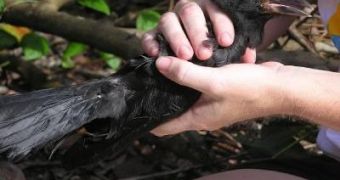Researchers from the University of Washington say that if no conservation measures are taken, the Mariana crow – a forest crow living on Rota Island in the western Pacific Ocean, will be extinct in 75 years.
There are about 35 crow species known today, and Mariana crows are considered rare and classified as critically endangered.
The birds weight about 227 grams (half a pound) and they are 40% smaller than other crows (the Northwest crow for example).
They are monogamously-mating, and live only on Rota Island, a US territory 56 miles northeast of Guam, up for consideration as a US national park and populated by nearly 1,200 people.
James Ha, University of Washington research associate professor in psychology and Renee Ha, co-author of the report and UW research scientist in psychology, believe that Rota could share the fate of Guam, an island with no birds at all.
After World War II, brown tree snakes were introduced to the island and eradicated all native birds (like the Guam flycatcher and the Rufous fantail), and now, the Has think that the uncontrolled increase of feral cats on Rota is causing the decrease of Mariana crows.
The problem is that their extinction could happen almost twice as soon as previously believed.
Ha looked at survival rates in 97 Mariana crows – Corvus kubaryi – that had been tracked between 1990 and 2010 by researchers, and he found that only 40% of fledgling crows made it to their first birthday.
This decline of young birds is twice as fast as researchers previously estimated.
Ha, who is the lead author of a report on the research, said that “it's the first year of survival that's the most crucial.
“If only 40 percent of fledglings survive their first year, then we predict the species will go extinct in 75 years.”
This estimated time to extinction was calculated based on 330 population of Mariana crows, with the 40 percent first-year survival rate, average number of fledglings per nest and fertility of female birds.
According to this model, in 20 years there will be 91 birds left and in 75 years the species will be extinct
Previous estimations accounted for a higher first-year survival rate of the Mariana crows, about 60-80%.
When Ha used those estimates in his population model, the future of these birds was not so dark – at 60% first-year survival rate, Mariana crows would decrease to 218 birds in 20 years and become extinct in 133 years.
And at 80% first-year survival rate, the species would have been saved because in 20 years there would be a growing population of 453 birds.
So Ha concluded that “according to the population model, if we can boost fledgling survival from 40 percent to 70 percent, the Mariana crows will be fine.”
For this, it is necessary to implement a bird management program that focuses on helping fledgling birds pass their first year of life.
The report was published in the current issue of Bird Conservation International.

 14 DAY TRIAL //
14 DAY TRIAL //